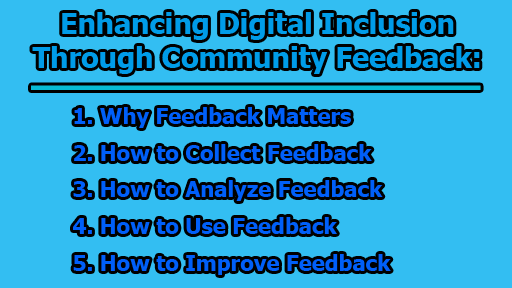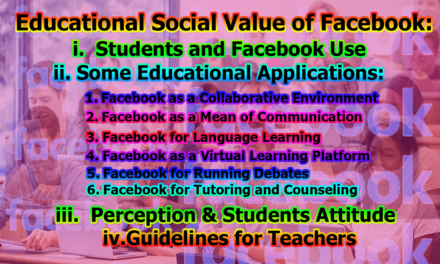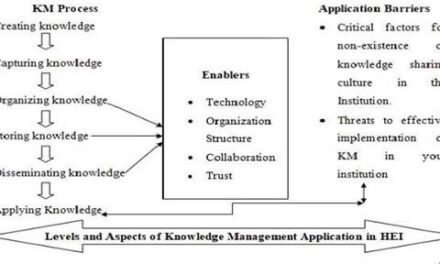Enhancing Digital Inclusion through Community Feedback:
Digital inclusion is a critical goal in our increasingly technology-driven world. It aims to ensure that everyone, regardless of their background or circumstances, has access, skills, and the confidence to harness the benefits of digital technologies for personal, social, and economic growth. Libraries play a pivotal role in promoting and supporting digital inclusion, particularly for marginalized and underserved communities. To create effective digital inclusion programs, libraries must actively engage with their communities and leverage their feedback to improve the programs’ relevance, engagement, and impact. In the rest of this article, we will explore enhancing digital inclusion through community feedback.
1. Why Feedback Matters: Feedback is a vital resource libraries can use to improve their digital inclusion programs. It serves as a rich source of information derived from users and stakeholders’ experiences, opinions, and suggestions about these programs. Here are several compelling reasons why feedback is so crucial:
- Program Evaluation: Feedback enables libraries to evaluate the outcomes and impacts of their digital inclusion programs. It helps in determining what aspects of the programs are successful and where improvements are needed.
- Identifying Strengths and Weaknesses: Community feedback helps libraries identify both strengths and weaknesses in their programs. It highlights the aspects that are working well and those that need enhancement.
- Adjustments and Changes: With feedback, libraries can make necessary adjustments and changes to enhance their digital inclusion programs. This ensures that programs remain responsive to community needs.
- User and Stakeholder Engagement: By actively seeking feedback, libraries demonstrate a commitment to engaging with users and stakeholders. This builds trust and enhances community participation.
- Accountability and Transparency: Feedback provides a clear way to demonstrate accountability and transparency to funders, partners, and the community. It shows that libraries are actively working to meet the needs of their constituents.
- Progress Measurement: Libraries can use feedback to measure their progress toward digital inclusion goals and gain insights into what strategies are effective and what needs improvement.
2. How to Collect Feedback: The method for collecting feedback depends on the purpose, available resources, and the context of the digital inclusion program. Here are various approaches that libraries can use:
- Surveys: Surveys are a common method to ask users or stakeholders to rate, rank, and answer questions about digital inclusion programs.
- Interviews: Conduct one-on-one or group interviews to have in-depth conversations about the programs and gather detailed feedback.
- Focus Groups: Facilitate discussions on programs with a small group of people to gain collective insights.
- Observations: Document user behaviors, reactions, and interactions while participating in programs or using digital resources.
- Feedback Forms: Use feedback forms to capture ratings, comments, and suggestions at the end of programs or sessions.
3. How to Analyze Feedback: Once feedback has been collected, it is essential to analyze it systematically. The following steps can guide the analysis process:
- Categorization: Organize feedback into categories, themes, or patterns using spreadsheets, databases, or software.
- Coding and Labeling: Use codes, labels, or tags to mark feedback based on criteria or indicators.
- Quantification: Utilize statistics, graphs, or charts to visualize the frequency, distribution, or correlation of responses.
- Qualification: Enhance the analysis by using narratives, quotes, and stories to illustrate the depth, diversity, or complexity of responses.
- Interpretation: Interpret the feedback using logic, reasoning, or frameworks to explain the causes, consequences, and implications of the responses.
4. How to Use Feedback: Once feedback has been analyzed, it’s time to put it to practical use to improve digital inclusion programs:
- Communication: Share the feedback with relevant stakeholders through reports, presentations, newsletters, or social media to inform them about the results and recommendations.
- Action: Make changes, adjustments, or innovations in the digital inclusion programs based on the feedback. Prioritizing, piloting, or scaling strategies can help with this.
- Tracking: Measure, evaluate, and report on the outcomes, impacts, or changes in the programs after implementing the feedback using indicators, metrics, or dashboards.
- Learning: Reflect, review, and revise digital inclusion programs collaboratively and continuously based on the feedback. Methods like debriefing, feedback loops, or learning circles can be invaluable.
5. How to Improve Feedback: Feedback is an ongoing process, and it can always be enhanced. Here are ways to continuously improve the feedback loop:
- Planning: Plan the feedback process by defining clear objectives and questions for collecting and using feedback.
- Involvement: Involve users and stakeholders in the process by consulting, engaging, or co-creating digital inclusion programs and the feedback process.
- Diversification: Use various methods, sources, and perspectives to collect and use feedback. This ensures a more comprehensive understanding of community needs.
- Testing: Pilot, experiment, or prototype digital inclusion programs and the feedback process before scaling or expanding them. This helps identify potential issues and address them proactively.
At the end of the day, we can say that community feedback is a powerful tool for libraries and other organizations committed to digital inclusion. By actively seeking, analyzing, and acting on feedback, libraries can make their digital inclusion programs more responsive, effective, and sustainable. This comprehensive guide serves as a roadmap for leveraging community feedback to achieve the ultimate goal of ensuring that everyone can reap the benefits of digital technologies.

Assistant Teacher at Zinzira Pir Mohammad Pilot School and College










